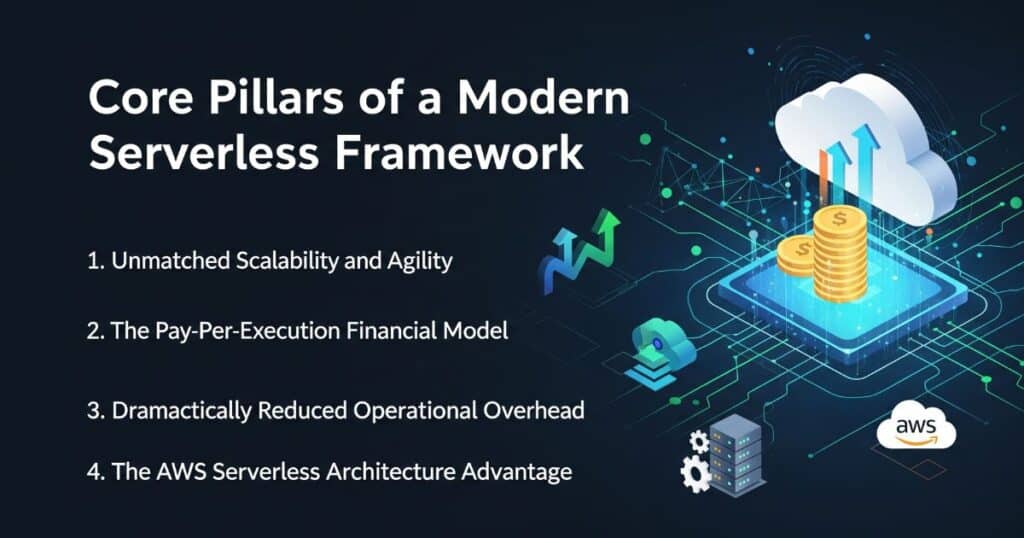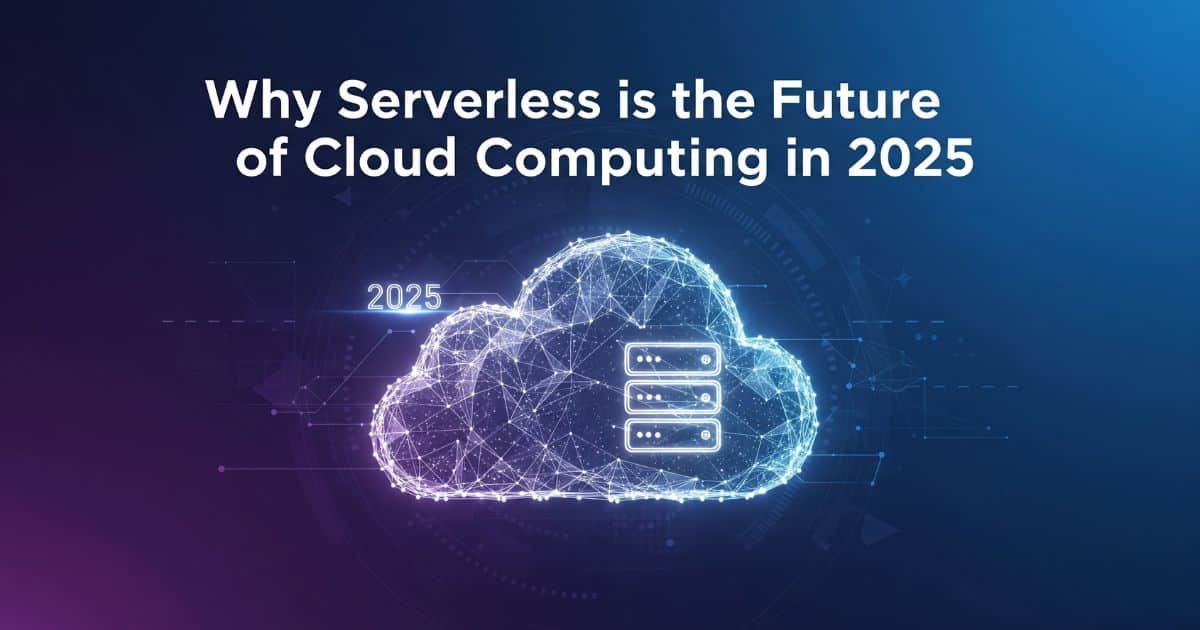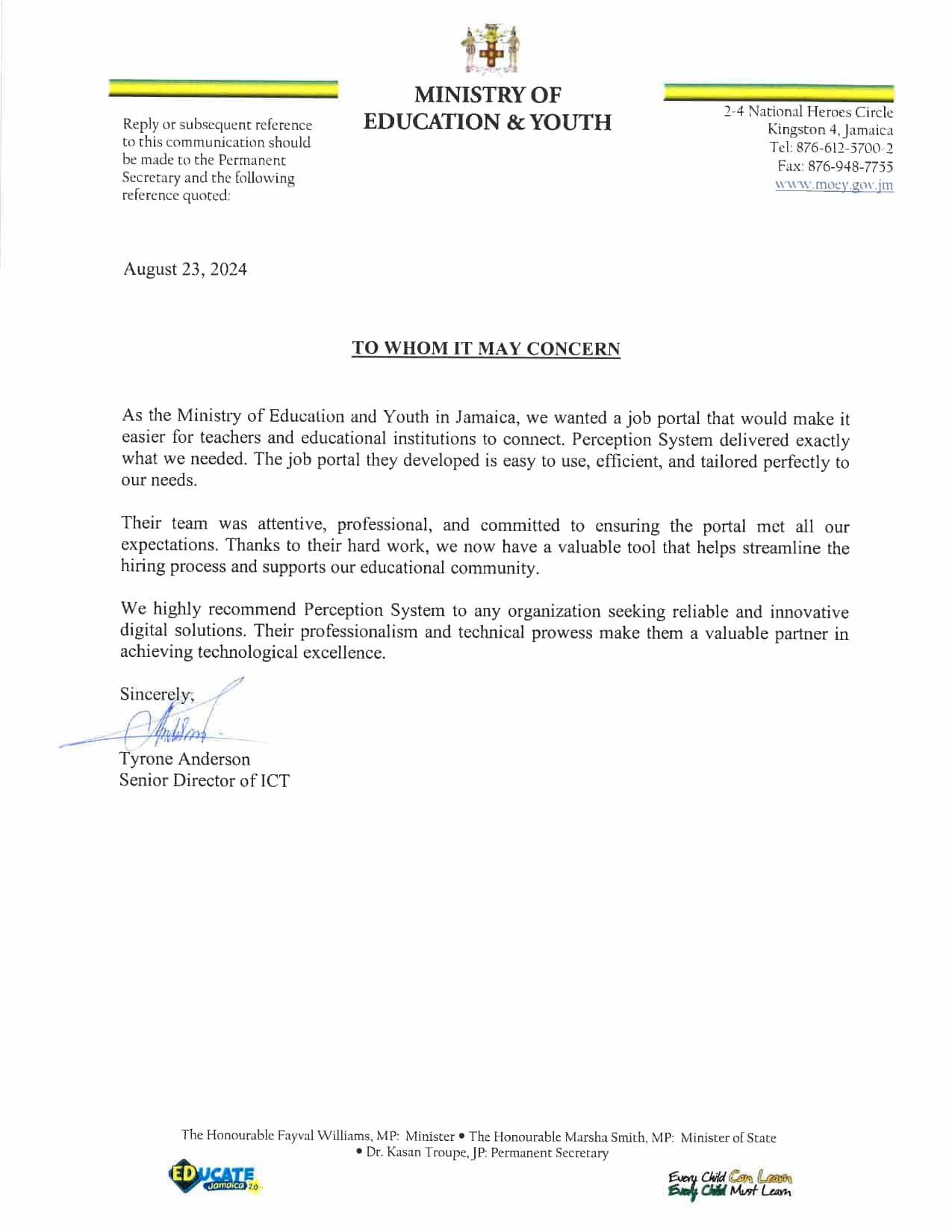Table of contents:
The Essence of Serverless: A Paradigm Shift Core Pillars of a Modern Serverless Framework
1. Unmatched Scalability and Agility
2. The Pay-Per-Execution Financial Model
3. Dramatically Reduced Operational Overhead
4. The AWS Serverless Architecture Advantage
The digital world is moving faster than ever, and at the heart of this rapid evolution is a fundamental shift in how we build and scale applications. For years, the story of cloud computing was about renting and managing servers. Now, in 2025, that narrative is changing completely. The new chapter is defined by a concept that abstracts away the complexities of infrastructure, giving developers and businesses the freedom to innovate without limits: serverless architecture.
With market projections for serverless solutions soaring, it’s clear that this isn’t just a fleeting trend. Industry analysis points to the serverless computing market reaching over $76 billion by 2030, a testament to its transformative potential. But what exactly is driving this growth, and why are forward-thinking organizations—from nimble startups to global enterprises—making the move? This blog post will delve into the core reasons why serverless is emerging as the definitive model for cloud computing and how it is shaping the technological landscape for years to come.
The Essence of Serverless: A Paradigm Shift
Before we delve into the future, let’s establish a clear understanding of the present. At its core, serverless computing doesn’t mean there are no servers. Rather, it means that the servers and their management are handled entirely by a cloud provider like AWS, Azure, or Google Cloud. Developers simply upload their code, and the provider takes care of everything from provisioning the underlying resources to scaling them up or down.
This model fundamentally reorients the focus of development. Instead of worrying about server maintenance, operating system patches, or load balancing, teams can concentrate solely on writing the business logic that provides value. This operational simplicity is the foundational stone upon which all the other benefits are built. A prime example of this model in action is Serverless Application Development, where an entire application is built using event-driven functions and managed services. This approach allows for unprecedented agility and efficiency.
Core Pillars of a Modern Serverless Framework

In 2025, the serverless ecosystem is more mature and robust than ever, powered by a complete Serverless Framework that simplifies every step of the development and deployment process. This framework is built on several key pillars that collectively make it a compelling choice for any modern application.
1. Unmatched Scalability and Agility
Traditional cloud models require you to provision resources for peak traffic, leading to underutilization and wasted costs during off-peak times. In contrast, serverless functions scale automatically and instantaneously. When a function is invoked, the cloud provider spins up a new instance to handle the request. When demand drops, it scales back to zero. This elastic scalability means your application can handle a sudden spike in traffic during a holiday sale or a viral marketing campaign without any manual intervention, ensuring a consistently smooth user experience. This also means you can test and deploy new features faster, as you are not constrained by fixed infrastructure.
2. The Pay-Per-Execution Financial Model
One of the most appealing aspects of serverless is its cost-effectiveness. The billing model is based on execution time and resource consumption, typically measured in milliseconds. You only pay when your code is actually running. This contrasts sharply with traditional models where you pay for a server that sits idle, consuming resources even when no one is using it. For applications with unpredictable or infrequent traffic, like a scheduled job or an event-driven data pipeline, this can lead to substantial cost reductions. Organizations leveraging this model for their web portal development services often report significant savings, as they only pay for the specific moments a user interacts with the portal, rather than a full-time server.
3. Dramatically Reduced Operational Overhead
Managing servers is a time-consuming and often complex task. It involves configuring hardware, updating software, applying security patches, and monitoring performance. Serverless architecture offloads all of these responsibilities to the cloud provider. This “no-ops” (no operations) approach frees up valuable developer time, allowing teams to dedicate their energy to creating new features, fixing bugs, and innovating. For a small team, this can be the difference between getting a product to market quickly and getting bogged down in maintenance. The ability to avoid this kind of administrative burden is a major reason why many companies, including those who rely on ats software development for their core business, are moving to a serverless-first strategy.
4. The AWS Serverless Architecture Advantage
As the pioneer in the space, Amazon Web Services (AWS) has built a comprehensive and deeply integrated AWS Serverless Architecture that leads the industry. Services like AWS Lambda, Amazon API Gateway, and Amazon S3 work together seamlessly to create a powerful and efficient application ecosystem. This maturity means that developers have access to a rich set of tools and services to build virtually any kind of application. From event-driven microservices to complex machine learning workflows, the AWS platform provides a reliable and scalable foundation. For businesses seeking to optimize their cloud operations on this platform, engaging in strategic AWS Consulting can provide the expert guidance needed to fully harness its power.
A Deep Dive into the 2025 Serverless Landscape
Beyond the core benefits, several emerging trends and technological integrations are cementing serverless as the future of cloud computing in 2025.
The Rise of Hybrid and Multi-Cloud Architectures: While a single cloud provider like AWS offers an incredibly complete ecosystem, businesses are increasingly adopting multi-cloud strategies to avoid vendor lock-in and leverage the unique strengths of different providers. Serverless frameworks and standardized interfaces are making it easier to deploy functions across multiple clouds, giving organizations the flexibility they need. This approach is becoming a standard for sophisticated enterprises aiming for maximum resilience and cost optimization.
Integration with AI, ML, and Edge Computing: In 2025, serverless computing is a cornerstone for applications that rely on real-time data processing and artificial intelligence. Functions are perfectly suited for running AI inference models or handling data from IoT devices at the edge, where latency is critical. For example, a retail company might use serverless functions to instantly process images for product recommendations, or a healthcare provider might use them to analyze data streams from medical sensors. This synergy between serverless and other cutting-edge technologies is opening up new frontiers for innovation.
Sustainability and Green Computing: The “pay-per-use” model of serverless computing also has a significant environmental benefit. By eliminating idle servers, it drastically reduces wasted energy consumption. Cloud providers are also making huge strides in powering their data centers with 100% renewable energy, making serverless an environmentally responsible choice for organizations committed to sustainability. According to a study by the MDPI, serverless architectures can reduce energy consumption by up to 70%, contributing directly to global green computing initiatives.
Tackling the Challenges Head-On
While the advantages are compelling, a responsible discussion of serverless computing must also address its challenges. The industry, however, will have made remarkable progress in solving these issues by 2025.
Cold Starts: The “cold start” problem occurs when a function is invoked after a period of inactivity, causing a slight delay as the cloud provider initializes the execution environment. While this was a major concern in the past, platform improvements and strategies like provisioned concurrency and optimizing function code have significantly mitigated its impact. Developers now have the tools and best practices to minimize these delays, making serverless suitable for even latency-sensitive applications.
Debugging and Observability: In a distributed, event-driven architecture, tracking down the root cause of an issue can be challenging. To solve this, modern observability platforms offer sophisticated features like distributed tracing and real-time log analysis. These tools provide a comprehensive view of how a request flows through various functions and services, making it easier to pinpoint and resolve problems. For a company like Perception System, offering expert assistance to clients on these platforms is essential for successful implementations.
Security: Breaking down an application into multiple functions can create more potential entry points for security vulnerabilities. However, modern serverless security is being addressed with a zero-trust model, where each function is treated as untrusted until verified. Tools for automated secret management and granular Identity and Access Management (IAM) permissions ensure that each function has only the minimum necessary access to resources, significantly reducing the attack surface.
The Ecosystem: Frameworks, Tools, and the Role of Expertise
To get the most out of a serverless approach, developers and businesses rely on a robust ecosystem of tools and frameworks. The open-source Serverless Framework has been instrumental in democratizing Serverless App Development, providing a single, unified command-line interface to deploy applications to various cloud providers. This simplifies the often-complex process of configuring and managing serverless resources. The framework, combined with specialized tools, has made the transition to serverless far more accessible for teams of all sizes.
For those looking to build a career in this field, honing skills in areas like moodle development or becoming a certified HubSpot CMS Developer can be a fantastic way to apply serverless principles to content and educational platforms.
Conclusion: Embracing the Serverless Future
Serverless computing has transcended its status as a niche technology. In 2025, it has evolved into a mature, practical, and strategic choice for organizations looking to simplify their cloud operations, accelerate development cycles, and reduce costs. The financial efficiency of a pay-per-use model, combined with the automatic scaling and reduced operational overhead, makes it an intelligent path forward.
For any business, the decision to modernize is about staying competitive. Serverless empowers teams to focus on what matters most: innovation and creating value for their customers. It allows a business to build a responsive, resilient, and highly scalable digital presence without the burden of constant infrastructure management. Whether you’re building a new product or modernizing an existing one, embracing a serverless-first mindset can provide a significant competitive edge.
If you are a business considering this transition, a partner with deep expertise can make all the difference. At Perception System, our cloud computing experts are dedicated to helping businesses navigate the complexities of modern cloud architecture. We provide comprehensive guidance and hands-on support for building future-proof solutions. To learn more about how we can help you with your next cloud initiative, feel free to contact us.




